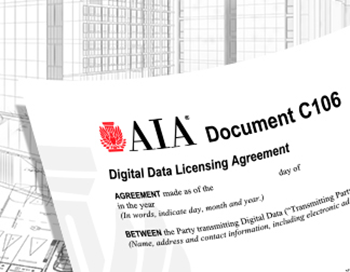Building information modeling (BIM) is the growing area of the building industry that continues to change how projects are designed and executed. BIM moves the design drawings from a 2D representation to the 3D one. It also promises the creator the opportunity to streamline the shop drawing process. Overall, the benefits of BIM include risk reduction, and quality and efficiency improvements.
Initially, BIM’s impact was typically utilized on the design side, where it allowed architects to visualize and design a project in exciting innovative ways. However, the efficiencies BIM offers were realized by the other major members of the construction industry. Contractors now use BIM to more accurately estimate, schedule, and execute a project’s construction.
When using innovative technologies like BIM, it’s crucial that all project participants understand their roles and responsibilities. AIA Contract Documents offers BIM and Digital Practice documents that establish expectations for the use and transmission of digital data. The BIM and related Digital Practice Documents help create a guideline for working with BIM and other digital practices. They address issues that may arise throughout a project and reduce barriers that often hinder BIM adoption.
AIA Contract Document BIM and Digital Practice documents include:
- C106 -2013, Digital Data Licensing Agreement
C106-2013 serves as a licensing agreement between two parties for the use and transmission of digital data, including instruments of service. C106-2013 allows one party to (1) grant another party a limited non-exclusive license to use digital data on a specific project, (2) set forth procedures for transmitting the digital data, and (3) place restrictions on the license granted. In addition, it allows the party transmitting digital data to collect a licensing fee for the recipient’s use of the digital data. - E203-2013, Building Information Modeling and Digital Data Exhibit
The primary purpose of E203-2013 is to initiate, at the outset of a project, a substantive discussion about the extent to which Digital Data and BIM will be utilized, and how Digital Data and models can be used and relied upon. This exhibit can be attached to an existing agreement that establishes the parties’ expectations for the use of digital data and building information modeling (BIM) on the project and provides a process for developing the detailed protocols and procedures that will govern the development, use, transmission and exchange of digital data and BIM on the project. Once agreed to, E203–2013 states that the relevant protocols and procedures will be set forth in AIA Documents G201–2013 and G202–2013.
The agreements made in E203–2013 include a reference to the dated version of the incorporated E203–2013. For example, in B101–2017, the Owner and Architect would list and incorporate E203–2013 in Article 13. Through this process, the various Project Participants begin the Project with a mutual understanding of how Digital Data and BIM will, generally, be utilized on the project. - G201-2013, Project Digital Data Protocol
G201–2013 allows the Project Participants to document the Digital Data protocols for the Project. The protocols are established in the form documents, rather than in the Agreement, because it is likely that the protocols will change as the Project progresses. If the protocols were included in the agreements, the Project Participants would need to amend all of their agreements every time the protocols changed, which would be taxing. Consequently, G201–2013 provides a space on the cover page to allow the Parties to add a version number and a date, in order to differentiate between newer and older versions. For example, as the Project moves into construction, the list of Project Participants responsible for creating, transmitting, and reviewing Digital Data will probably grow and change pointedly, and the distribution list should reflect the current Project Participants.
Coordinated for use with E203–2013, this form documents the agreed upon protocols and procedures that will govern the transmission, use and exchange of digital data on a project, such as electronic project communications, submittals, contract documents, and payment documents. G201–2013 is not designed to address Building Information Modeling protocols and procedures, which is the purpose of AIA Document G202–2013, Project Building Information Modeling Protocol Form. - G202-2013, Project Building Information Modeling Protocol Form
G202-2013 is an extension of E203-2013. The E203-2013 exhibit records the Parties’ intentions regarding the use of Modeling on the Project, the Anticipated Uses of the Model and other basic assumptions about the roles and responsibilities of the Parties, and contractually obligates the Parties to have discussions to establish and follow protocols for the development and use of Models on the Project. The G202-2013 documents the agreed upon protocols and procedures that will govern the development, transmission, use and exchange of building information models on a project. It establishes the requirements for model content at five levels of development, and the authorized uses of the model content at each level of development. G202-2013 defines the extent to which model users may rely on model content, clarifies model ownership, and sets forth building information modeling standards and file formats.
Accordingly, as is the case with G201–2013, G202–2013 includes a fill point to allow the Parties to designate a revision number and date to differentiate between newer and older versions of the Building Information Modeling protocols.
Find samples of BIM and Digital Practice documents at aiacontracts.org. Click here to get free samples of the recently-released 2017 versions of AIA Contract Documents.


